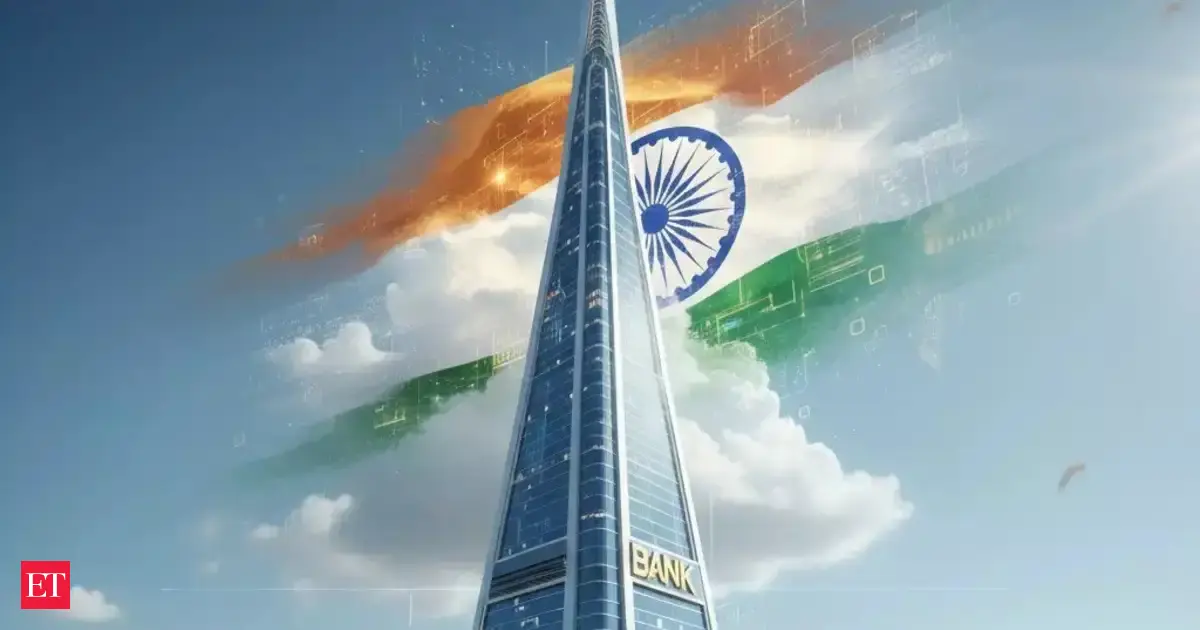Copyright indiatimes

Representative AI image India is turning its gaze toward the creation of global-scale banks, which would be mega institutions capable of financing the country’s growing ambitions in infrastructure, manufacturing and technology. The government’s renewed focus on consolidation among public sector banks (PSBs) signals not just a domestic reform effort but a broader strategic bid to position Indian lenders alongside global financial giants. The move aligns with the nation’s long-term “Viksit Bharat 2047” vision of becoming a developed economy and underscores a belief that scale, stability and competitiveness in banking are indispensable to sustaining rapid growth.India’s ambition to create at least two globally competitive banks among the world’s top 20 aligns with its broader developmental goals. The “Viksit Bharat 2047” roadmap envisions an economy capable of financing its own transformation. For this, financial institutions must be able to handle the scale of lending needed for green energy corridors, smart cities, and next-generation manufacturing.Also Read: Discussing with RBI, banks on consolidation, says FM Nirmala SitharamanUnion Home Minister Amit Shah recently articulated this aspiration succinctly, urging the banking sector not just to aim for growth but to “change the scale.” His call resonates with India’s need to move from a system of many small, safe banks toward a few globally significant institutions that can serve as the financial backbone of a $10-trillion economy.The rationale for consolidationIndia’s banking landscape has long been characterised by fragmentation, with a multitude of public sector banks operating with overlapping mandates and varying degrees of strength. The government’s first major consolidation drive in 2020 reduced the number of state-owned banks from 27 to 12, aiming to create institutions with stronger balance sheets and broader reach.Live EventsYou Might Also Like:FinMin for creation of two globally competitive banks as part of Viksit Bharat visionThis process improved efficiency and allowed weaker banks to find stability under stronger anchors. However, while it achieved administrative streamlining, it did not dramatically alter India’s position in the global banking hierarchy. Together, the 12 PSBs still hold assets worth around Rs 171 trillion (approximately USD 1.95 trillion) which is barely enough to place even their combined balance sheets just above Wells Fargo, currently around the 15th largest bank in the world.The government now intends to push this effort further. The new consolidation round under consideration could merge stronger, mid-sized PSBs such as Bank of Baroda, Bank of India and Bank of Maharashtra into larger, more competitive entities. Unlike the earlier mergers that primarily involved weaker banks, this phase seeks to build globally resilient institutions, not just rescue struggling ones.Why size mattersGlobally, the scale of financial institutions plays a defining role in their ability to fund large-scale projects, manage risks and influence markets. India’s largest lender, the State Bank of India (SBI), has assets of around USD 846 billion, placing it 43rd in S&P Global’s 2024 list of the world’s largest banks. For SBI to break into the top 10, its balance sheet would need to triple in size. In contrast, the 10th largest bank, Japan’s Mitsubishi UFJ Financial, manages assets exceeding USD 2.6 trillion.You Might Also Like:India aims for two PSBs on world top 20 list by 2047This gap is not merely symbolic. Large banks are better positioned to support multi-billion-dollar infrastructure projects, participate in global syndications and raise capital on favourable terms in international markets. As India expands its infrastructure, green energy industry and manufacturing bases, access to vast pools of capital becomes critical. Large domestic banks would be pivotal in channeling such funds efficiently while maintaining financial sovereignty.Reform beyond mergersExperts caution that mergers alone cannot create world-class banks. Sanjay Kumar Agarwal of CARE Ratings told ET recently that consolidation must be paired with reforms in governance, human resources and technology. Large banks need market-linked remuneration structures to attract and retain top financial talent, as well as professional management practices that reduce political interference.Moreover, the success of any mega-bank hinges on its ability to modernise through digital transformation, data-driven lending and integration of advanced risk management systems. The ability to operate seamlessly in global markets requires not only capital adequacy but also institutional agility. Without these, scale could turn into bureaucratic inertia rather than competitive strength.Another vital element in this reform package is capital infusion. The government’s proposal to raise the foreign investment limit in PSBs from 20% to 49% could significantly improve their access to international capital. By aligning PSB ownership norms closer to those of private banks, where the cap is 74%, the government hopes to attract long-term strategic investors who can bring not only funds but also expertise and innovation.The Challenges aheadIndia's big banks ambition raises complex questions too. As some analysts point out, the ultimate goal should not merely be to climb global rankings but to enhance profitability, governance and service quality. A larger balance sheet does not automatically translate into better banking unless accompanied by efficiency, innovation, and prudential discipline.“Somehow, they feel size is everything. It is true that if the net worth gets bigger, they would be able to give larger corporate loans. But it is not the case now that the corporates want to borrow, and the banks do not have the size to lend. The plan seems to be merge and then privatise,” Hemindra Hazari, a senior banking analyst, was quoted as saying in a recent ET report. A lot of mergers do not work, Hazari says, adding that often they don’t achieve the synergies initially intended at the time of announcement. “In the case of SBI and its associates, they had a lot in common, the SOPs, the technology and even HR policies. But, in these banks, that is not the case, the cultures would be very different.” Also, banking needs a regional focus, which many of these smaller banks have. They have their own understanding of their customers and practices. Once you merge and become a national entity, this whole focus gets lost, Hazari adds.Despite the strategic rationale, the path to creating global-scale Indian banks will not be without hurdles. Merging large institutions involves complex integration of technology systems, harmonization of corporate cultures, and alignment of risk frameworks. Past mergers took years to stabilize operations, and employee unions have often resisted consolidation due to fears of rationalization and relocation.There is also the risk of concentrating too much systemic exposure in a handful of entities. While scale brings strength, it can also create “too big to fail” institutions that heighten systemic vulnerability if not managed prudently. Balancing efficiency with financial stability will thus remain a core challenge for regulators.Yet, the potential rewards are very significant. A handful of globally strong Indian banks could serve as champions of the country’s international trade, infrastructure finance and digital banking leadership. With a stronger capital base and better access to foreign markets, such banks could help Indian firms expand globally while providing the domestic economy with the credit depth it needs.Add as a Reliable and Trusted News Source Add Now! (You can now subscribe to our Economic Times WhatsApp channel) Read More News onstate bank of indiabank of barodaamit shahwells fargoindian banksindia big banksindia banks in world's top 20state banksindia bank mergerviksit bharat (Catch all the Business News, Breaking News and Latest News Updates on The Economic Times.) Subscribe to The Economic Times Prime and read the ET ePaper online....moreless (You can now subscribe to our Economic Times WhatsApp channel)Read More News onstate bank of indiabank of barodaamit shahwells fargoindian banksindia big banksindia banks in world's top 20state banksindia bank mergerviksit bharat(Catch all the Business News, Breaking News and Latest News Updates on The Economic Times.) Subscribe to The Economic Times Prime and read the ET ePaper online....moreless



